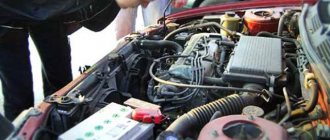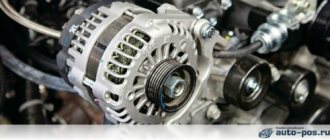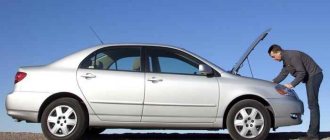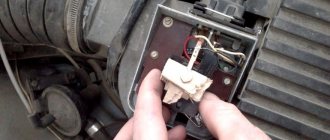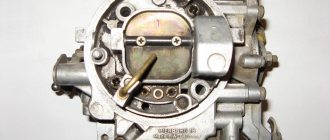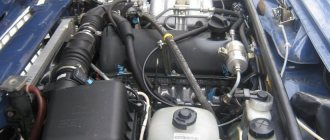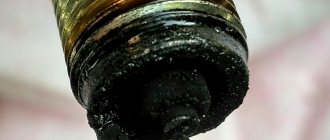Surely every car owner has experienced such an unpleasant situation when the car stalls when releasing the gas.
This problem is one of several most common. To begin with, I would like to clarify why the engine may be plugged during a reset. The very first and most common problem is the banal clogging of the gap in the throttle valve. Another equally popular problem is the dying of the regulator, and they can break quite often.
It’s not uncommon to hear from people that it got to the point where they had to completely change it. Or some people benefit from a very serious and deep flush.
Problems and their solutions
The car stalls when you let off the gas - but what exactly lies behind this problem? Everything is quite simple, after reaching a certain speed, the foot is removed from the gas pedal and the car simply stalls. With all this, when the ignition is applied and at idle, everything works more than with a bang.
Despite the advice given above, the problem may not be solved, since they are general preventive measures for a stalled engine. As for the problem itself, it’s worth paying attention to several sensors.
Visiting a car service center
In a situation where you specifically do not have enough experience in car maintenance, there is a fairly high probability of aggravating the problem by unqualified intervention in the operation of various on-board systems.
It is important to objectively assess your own capabilities, and if you don’t have faith in yourself, then it is better to entrust the repairs to specialists. In a situation where it turns out that the problem is not particularly serious, they will not take much money from you. But in any case, you will be able to avoid many of the troubles associated with unqualified attempts to repair the vehicle.
Sensors
The first of them is the idle speed sensor.
This device is located in the engine control system. It is used in cars to stabilize idle speed. Its abrupt performance often precedes the engine turning off when the gas pedal is released. If this is exactly the sequence, then with a 90% probability this particular sensor is involved and you need to start digging in its direction. As you can understand, this sensor is designed to supply air to the engine to maintain normal idle speed. This sensor is a very important component of the entire fuel supply system to the engine, and it works closely with the injection system.
Second
– this is an air flow sensor, it is located in the same system as the previous one, only it works more globally and is responsible for a greater number of operations.
If this is not the problem, then you can look towards low-quality gasoline (this happens, and not rarely). So, you should pay great attention to the selection of gasoline. Additional article “Which cars require 98 gasoline.”
{banner_content}
Throttle valve
A dirty throttle body could very well be the cause. The Priora has difficulty starting when cold due to the supply of not clean air through the damper, but with various deposits. All this can prevent the preparation of a normal mixture in the correct proportions.
Sometimes the throttle valve can even get stuck due to the huge amount of deposits on it. To solve the problem, experts recommend cleaning the throttle - you can do this yourself using an injector cleaning spray.
Other reasons and their solutions
Another reason may be the wedge of the XX valve. This problem can be temporarily solved by simply tightening the throttle cable a little. Then see what happens. The notorious XX sensor can also be involved here. It also contains more than a dozen problems, but most of them can be solved by simple washing.
It is the sensor that is washed
, or to be more precise, its components in the form of a needle and its hole where it enters. Checking its functionality is quite simple, you need to remove the sensor itself, activate the connector, then disconnect the battery for a short period of time, then connect it again and turn on the ignition, you will see how the needle begins to make forward-return movements.
Another reason could be the battery terminal. In order for everything to be in order, it needs to be reset, so that it can incorrectly transfer data to the engine control settings.
This procedure resets all system settings, and it will again learn to gain and maintain the correct idle speed, and only 3-5 trips may be enough for this. This does not always happen, but still, such a process is called “self-learning”.
It is also possible, and even necessary, to check the injectors; it is possible that the problem lies in their contamination or even technical wear, and, as a result, in their malfunction. Read the article “How to clean injectors.”
Washing everything and everyone should be done exclusively with WD-40 washing liquid.
If the Lada Priora's starter does not turn
Possible malfunction
Burnt starter commutator, stuck brushes or severe wear
Open or short circuit in the starter armature winding
| Diagnostics | Remedies | |
| Low battery | The voltage at the battery terminals without load is less than 12V. When trying to start the engine, a cracking noise is heard from under the hood. | Charge the battery or replace it with a new one |
| Oxidation of battery terminals or wire terminals, their fit is not tight | When you try to start the car, the voltage in the on-board network drops much more than at the battery terminals. In this case, a crash may be heard under the hood. | Clean the contacts, lubricate them with petroleum jelly and tighten the terminals |
| The engine or attachments are jammed | Check the rotation of the crankshaft, pump and generator pulley. | Repair engine, generator, pump |
| The starter is faulty, the starter drive gear or flywheel ring teeth are damaged | Remove and inspect the starter. | Repair or replace starter |
| The starter switching circuit or starter relay is faulty, the wires are damaged, or the ignition switch contacts do not close | When the key is turned to position “II”, the starter traction relay does not operate (a click is not heard under the hood). Check the +12V supply to the control contact of the traction relay. | Replace starter relay, wires, ignition switch |
| The starter traction relay is faulty, there is a short circuit or break in the retractor winding, the relay armature is stuck | When the key is turned to position “II”, the traction relay does not operate (there is no click under the hood), but + 12V is supplied to the control contact of the traction relay. Remove the relay and check its operation. | Replace the traction relay |
| Contacts or wires of the traction relay are oxidized, poor ground contact | When the starter is turned on, a clicking sound is heard under the hood, but the starter armature does not rotate. Using an ohmmeter, check the resistance of the battery-starter circuit, as well as the ground wire. If the circuit is in good condition, remove the starter and check the operation of the traction relay by applying +12V to it from the battery | Tighten the terminals, clean the contacts, replace the traction relay |
| Open or short circuit in the holding winding of the traction relay | When you try to start the engine, you hear a crashing sound under the hood. The battery voltage is within normal limits. We check the traction relay with an ohmmeter or by its excessive heating. | Replace the traction relay |
| The starter armature rotates slowly or does not rotate at all. Check the traction relay by applying voltage to the starter contact bolt directly from the battery | Replace starter or armature | |
| Freewheel slipping | When the starter is turned on, the armature rotates, the flywheel is stationary | Replace clutch or starter |
A trip to the workshop
As you can see, everything described above can be done by a person who knows the structure of the car, but there is nothing for a beginner, because not every novice car enthusiast knows where the XX valve is located, much less its sensor. There is a high probability that outside interference will only make everything worse, or will break or spoil something that was originally in working order. So here it’s worth setting priorities and logically assessing your chances of correcting all problems yourself.
Naturally, in moments when the car stalls when releasing the gas, few people are interested in why this is happening, so it would be very advisable to call a tow truck and tow the car for repairs, or, if the situation is not completely dire, then you can drive to the repair shop yourself .
The price for correcting problems will directly depend on their cause; if it is a simple flushing of sensors and valves, then it will not be very high.
In neutral the car stalls when the clutch is released
Friends, please help with advice.
Winter, a VAZ 21053 car is parked in the yard. In the morning I got behind the wheel and then, as I have been doing for many years, I pressed the clutch pedal to make it easier to start, and started the engine. Gearbox lever in neutral. I waited for the engine speed to increase and began to smoothly release the clutch pedal. The engine speed began to drop noticeably, and it was about to stall. At first I thought maybe the oil in the gearbox was too thick from the cold, so I waited with the pedal in an intermediate position. To no avail, it still stalls as soon as I start to fully release the clutch pedal. I played with the clutch pedal for about 10 minutes. To no avail, it stalls, although the gearshift lever has been in neutral all this time. To prevent the engine from stalling, I started pressing on the gas with my right foot. And then there was a sharp burning smell, smoke coming from under the hood - apparently the clutch was burning. I tried again on another day, when it was warmer outside, around zero - also to no avail. The gearshift lever itself moves and locks in all positions normally. In connection with what happened, I have several questions: 1. What exactly could have happened to the car? 2 What parts may need to be changed? 3. Has my clutch completely burned out? It is new, only 5 thousand have passed. Is there a chance to return it to the store under warranty? (The car is not new, 65 thousand km) 4. I can’t fix it myself, at least enough to get to the service center? I only have experience with the simplest repairs. Besides, it's winter now. 5. Can a specialist, for example, from the “Angel” service, repair the car on the spot or is it inevitable to call a tow truck and transport it to a service center? 6. What type of service is better to haul your car with a tow truck in winter? She won’t even be able to enter the deputy’s service room.
I understand that it is difficult to give accurate answers to all questions without seeing the car. Therefore, I still thank you in advance even for approximate and incomplete answers.
Source
Air leak in the intake manifold
Another reason why the engine does not develop speed may be a banal air leak in the intake manifold of the power unit. Symptoms of such a malfunction are difficulty starting the engine, its “triple”, problems with idling, increased fuel consumption and, of course, loss of speed. This all happens due to a sharp depletion of the mixture due to unaccounted air entering the combustion chambers.
Most often, system depressurization occurs due to wear of the intake manifold gasket. It is quite difficult to determine that an injection engine does not develop speed precisely because of air leaks, just as it is not easy to find the place of depressurization itself. It is better to entrust this to specialists. But there are some things you can try to do yourself. You can, for example, take a syringe with a needle, fill it with gasoline (or solarium for diesel units) and treat the perimeter of the junction of the manifold with the engine with fuel. If the gasket between them has become unusable, then gasoline will be sucked into the combustion chambers along with the air. If, after starting the engine, you notice positive changes in its operation, you can be sure that the reason lies precisely in the suction.
Why are the revs dropping?
Cases in which dips appear when you sharply press the gas are represented by incorrect operation of components in the car's power systems. Most problems occur on cars with carburetors. But even on injection models such cases are not excluded.
If there is a drop in speed when pressing the pedal vigorously, you need to inspect the accelerator pump. Most likely it is faulty. It is possible that the liquid content in the fuel level stabilization chamber has decreased. The problem manifests itself at the beginning of movement, at zero load, and when driving with a change of speed.
How to fix:
Requires monitoring of the fuel supply system in the carburetor
Pay attention to the following components - atomizer, channels, inspect the valves, diaphragm. The filter element located at the inlet is checked. The appearance of dirt and blockages interferes with the flow of fuel, which is accompanied by a drop in the level in the stabilization chamber
After cleaning the filter, you can resume system operation. If there are blockages, it is recommended to pay attention to the fuel pump filter, fine filter and the filter element on the fuel intake in the tank.
Reasons for constant failures
While operating a car, it is easy to detect other signs and reasons why failure occurs when you press the gas pedal.
Common situations:
- Short-term jerks that appear under moderate load, when the car starts moving or at idle. The reason is related to the 1st chamber, where the outlet holes become clogged; problems with the accelerator pump are possible.
- Longer breaks, sometimes combined or turning into twitching. Noticeable when lightly accelerating, when the car is traveling at low or medium speed. If the signs disappear with active gas operation, it means there is a problem with the nozzle - it is clogged or not fully closed. It is possible that the elements of the dosing system may become clogged. You should be wary of a mismatch in the markings of the fuel nozzle, the possibility of air masses entering from the outside, or a drop in the amount of fuel in the float chamber.
- If, when you press the gas pedal, the drop in speed becomes regular, there is instability at zero load, swaying, signs indicate problems with the jet, CXX, EPH channels.
- Lack of response under heavy loads, when operation is noted with open throttle valves of the 1st and 2nd chambers. All this is accompanied by a drop in potential and pickup capacity. Such problems occur due to incorrect operation of the ecostat, problems with fuel due to interruptions, or clogging of gasoline supply units. There is a high probability of problems with the power mode economizer.
The functionality of the accelerator pump requires increased attention in most situations, because it is indispensable in the operation of the carburetor and power unit in all modes, in addition to idling.
Fuel quality
The use of high-quality gasoline or diesel fuel is the key to long-term engine life and obtaining maximum power indicators from it. But none of the drivers is completely immune from refueling with low-quality fuel, the use of which threatens not only a significant reduction in power indicators, but also the inability to start the engine. Regular use of low-quality gasoline manifests itself in intensive formation of carbon deposits on the cylinders, pistons, catalyst and exhaust manifold, as well as increased wear of the cylinder-piston group.
How to get rid of problems caused by a drop in speed
A failure in the engine during significant acceleration can occur for various reasons - this has already been dealt with. These reasons vary depending on what type of engine is installed in the car: carburetor or injection. Accordingly, methods for troubleshooting also vary. We have to deal with this now.
Checking the carburetor system
Initially, the operation of the fuel system is checked to see how smoothly and correctly it works. Every working unit and detail matters. Air leaks are checked, fuel lines are examined and the fuel pump is diagnosed. All blockages and deposits are removed.
If the diagnostics do not reveal any problems, then the carburetor may cause a failure in the engine when the gas pedal is pressed. This part is responsible for supplying fuel. During normal operation of the carburetor, fuel is supplied without interruption, constantly and evenly.
To identify and eliminate the cause of the problem, you must proceed as follows:
- We exclude air leaks, which may occur due to a loose fastening on the exhaust manifold.
- We study the condition of the mesh-type filter, which is located in the area where the pipe from the fuel pump connects.
- We dismantle the EPH valve and the sealing ring and examine their condition. If the EPHH is working properly, then when you connect one side of the wire to the terminal, and the opposite end to the positive terminal of the battery, a clicking sound will be heard.
- Check the liquid level in the float chamber. To do this, start the engine, leave it to run for a while, remove the top carburetor cover and filter housing. Now let's evaluate the fuel level. In normal condition, it should be in the middle of the inclined wall.
- The dosing system may become clogged and this is a common problem. To eliminate it, you will need to remove the top part of the dispenser and the jets. We look for blockages and remove them using wooden parts. Emulsion tubes, which are often forgotten, also need inspection and maintenance.
- Special products are used to clean the carburetor channels.
Drop in speed on injection models
In the case of injection cars, when failures occur in the engine, the fuel supply system is first checked to see how well this system works
What you need to pay priority attention to:
- Is there a blockage on the fine filter?
- The fuel pump operates stably.
- Clean filter mesh on the intake.
- Is the fuel rail pressure normal? The norm for this indicator starts from 2.8 and reaches 3.2 Bar.
- The sensors that regulate the formation and supply of the fuel mixture are functioning normally.
- How many errors have accumulated in the ECU?
- The throttle valve has collected debris.
- Injectors can cause failures in the operation of an injection engine when you press the gas pedal. We definitely check their functionality.
To carry out a complete diagnosis with your own hands, you need a multimeter and a pressure gauge. Some working components (injectors, throttle valve, ECU) can only be checked by specialists. If the cause has not been identified, then you need to check the ignition system
First of all, pay attention to the spark plugs. Then the wiring, main operating components and the installation itself are checked
Do not delay in solving the problem. It will not go away on its own, the situation will only get worse. Ultimately, more serious problems with the vehicle may arise that will take longer and be more expensive to fix. Moreover, the risk of accidents increases significantly. But you cannot skimp on safety; not only your life is at risk, but also that of other road users.
Source
Dips and uneven engine operation on the VAZ-2114
#1 St4n
Garage workers
2531 messages
Yesterday my combat VAZ decided to scare me - when driving around the city, the engine suddenly began to run unevenly. It was idling, when you pressed the gas, the vibration intensified, the car drove very poorly, did not pull, when you pressed the gas pedal, it first “failed”, and then barely drove, sneezing and farting. Moreover, the vibrations gradually became stronger, and the engine worked worse and worse - when I stopped at a traffic light, the car was already pounding, and the sound of the engine was similar to the “droning” of a Subaru Impreza.
At a traffic light, I turned off the engine and started it again - it got better, the engine started working more equally, but over time it also slowly gave out. I reached the parking lot and opened the hood - checked the level and condition of the oil, pulled the high-voltage wires - everything seemed to be normal. Five minutes later I started the car - it works fine, pulls normally, drives as if nothing had happened. I calmly went about my business, and then drove home - with the throttle evenly open (60 km/h), the car twitched a couple of times, as if there was something wrong with the fuel supply. However, I got home fine.
I started it this morning and it works great again, as if nothing had happened. I calmly drove to the auto shop (12 km) and back, without a hint of uneven operation (but subjectively, when you press the gas pedal sharply, you seem to feel a slight dip before picking up speed).
I also remembered that some time ago (a month, maybe) it happened a couple of times that the car would stall when releasing the gas and pressing the clutch (when approaching an intersection or crossing). It stalled - I started it with half a kick, then it drove normally, I forgot about it and gave up.
I think that the problem is somewhere in the throttle assembly - IAC, MAF, TPS, I will check first (although it turns out that the nodes seem to work, only periodically giving out malfunctions).
The car is 2008, mileage 82 thousand kilometers, engine from Kalina 1.6 with 8 bugs.
What else could be the reason? I ask for advice, share your experience.


